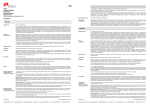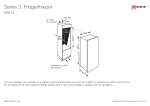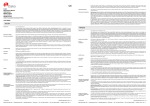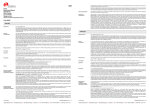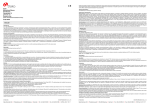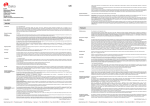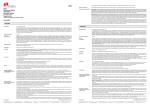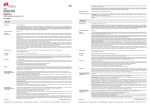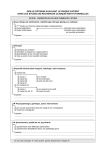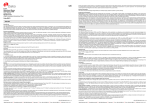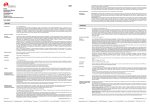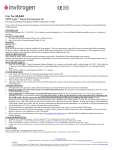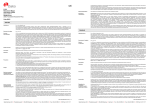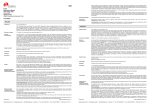Download FLEX Monoclonal Mouse Anti-Human BCL2 Oncoprotein
Transcript
Performance characteristics Normal tissues: The antibody labels almost all peripheral blood lymphocytes. In lymphoid tissue, small lymphocytes in the mantle zones and T-cell areas are positive whereas very few cells in germinal centres are labeled. In the spleen, many cells in both T- and B-cell areas and the red pulp are labeled by the antibody. In the thymus, many cells in the medulla are labeled, while most cells in the cortex show weak or negative staining (1). In tonsil, the lymphocytes in the peripheral mantle zone and interfollicular lymphocytes show a moderate to strong staining reaction, whereas basal epithelial cells show a weak to moderate staining reaction. Abnormal tissues: The antibody labeled many neoplastic cells including 31/38 of cases of diffuse lymphoma and lymphoproliferative disorders of low and high grade, including chronic lymphocytic leukemia, hairy cell leukemia, T-cell lymphoma, B- and T-cell large cell type and anaplastic large cell Ki-1 lymphoma, and 37/43 of neoplastic follicles in cases of follicular lymphoma (1). Expression of BCL2 oncoprotein was also detected in 15/19 of synovial sarcomas (6), and in muscle-derived tumors (7). Labeling was only observed in 5/21 Burkitt lymphomas, while 32/52 diffuse large B-cell lymphomas were positive with the antibody (2). FLEX Monoclonal Mouse Anti-Human BCL2 Oncoprotein Clone 124 Ready-to-Use (Dako Autostainer/Autostainer Plus) FRANÇAIS Code IS614 ENGLISH For in vitro diagnostic use. FLEX Monoclonal Mouse Anti-Human BCL2 Oncoprotein, Clone 124, Ready-to-Use (Dako Autostainer/Autostainer Plus), is intended for use in immunohistochemistry together with Dako Autostainer/Autostainer Plus instruments. This antibody labels cells expressing BCL2 oncoprotein. Positive results aid in the classification of follicular lymphomas and various diffuse lymphoproliferative diseases (1). Differential classification is aided by the results from a panel of antibodies. The clinical interpretation of any staining or its absence should be complemented by morphological studies using proper controls and should be evaluated within the context of the patient’s clinical history and other diagnostic tests by a qualified pathologist. This antibody is intended to be used after the primary diagnosis has been made by conventional histopathology using non-immunological histochemical stains. Intended use Utilisation prévue Pour utilisation diagnostique in vitro. FLEX Monoclonal Mouse Anti-Human BCL2 Oncoprotein, clone 124, Ready-to-Use (Dako Autostainer/Autostainer Plus) est destiné à une utilisation en immunohistochimie avec les instruments Dako Autostainer/Autostainer Plus. Cet anticorps marque les cellules exprimant l'oncoprotéine BCL2. Les résultats positifs aident à classer les lymphomes folliculaires et diverses maladies lymphoprolifératives diffuses (1). La classification différentielle est facilitée par les résultats provenant d'un panel d'anticorps. L'interprétation clinique de toute coloration ou son absence doit être complétée par des études morphologiques en utilisant des contrôles appropriés et doit être évaluée en fonction des antécédents cliniques du patient et d'autres tests diagnostiques par un pathologiste qualifié. Cet anticorps est destiné à être utilisé après un diagnostic primaire par histopathologie traditionnelle utilisant des colorations histochimiques non immunologiques. Résumé et explication L'oncoprotéine BCL2 est un bloqueur de l'apoptose (mort des cellules). Les expériences de transfert génique ont démontré que des taux élevés de cette protéine peuvent protéger une grande variété de cellules contre divers stimuli de mort cellulaire allant de la suppression du facteur de croissance et des lymphokines cytotoxiques aux infections virales et médicaments anticancéreux et rayons qui endommagent l'ADN (2, 3). L'oncoprotéine BCL2 réside sur le côté cytoplasmique de la membrane mitochondriale externe, du réticulum endoplasmique et de l'enveloppe nucléaire (2, 4), et possède une masse moléculaire de 26 kDa (3). Le gène BCL2 est impliqué dans la translocation chromosomique t(14;18) observée dans 85% des lymphomes humains folliculaires et 20% des lymphomes à lymphocytes B diffus (4). Dans cette translocation, le gène BCL2 sur le segment chromosomique 18q21 est juxtaposé au locus de la chaîne lourde d'Ig au segment 14q32, ce qui entraîne une expression dérégulée de l'oncoprotéine BCL2 (4). BCL2 oncoprotein is a blocker of apoptotic cell death. Gene transfer experiments have shown that elevated levels of this protein can protect a wide variety of cells from diverse cell death stimuli ranging from growth factor withdrawal and cytotoxic lymphokines to virus infection and DNA-damaging, anticancer drugs and radiation (2, 3). BCL2 oncoprotein resides on the cytoplasmic side of the mitochondrial outer membrane, endoplasmic reticulum and nuclear envelope (2, 4), and has a molecular mass of 26 kDa (3). The BCL2 gene is involved in the t(14;18) chromosomal translocation found in 85% of human follicular lymphomas and 20% of diffuse B-cell lymphomas (4). In this translocation, the BCL2 gene at chromosome segment 18q21 is juxtaposed with the Ig heavy chain locus at 14q32, resulting in deregulated expression of BCL2 oncoprotein (4). Summary and explanation Refer to Dako’s General Instructions for Immunohistochemical Staining or the detection system instructions of IHC procedures. Reagent provided Ready-to-use monoclonal mouse antibody provided in liquid form in a buffer containing stabilizing protein and 0.015 mol/L sodium azide. Clone: 124 (1). Isotype: IgG1, kappa. Immunogen Synthetic peptide comprising amino acids 41-54 of human BCL2 oncoprotein (1). Specificity In Western blotting of extracts of normal human spleen (1, 5), t(14;18)-positive follicular lymphoma (1), and myloid leukemic cell lines (5) the antibody labels solely a band of 26 kDa, corresponding to BCL2 oncoprotein under both nonreducing (1) and reducing conditions (1, 5). The antibody labels the myeloid leukemic cell lines, HL-60 (promyelocytic), KG1 (myeloblastic), GM-1 (monoblastic) and K562 (erythromyeloid) (5). Precautions 1. For professional users. 2. This product contains sodium azide (NaN3), a chemical highly toxic in pure form. At product concentrations, though not classified as hazardous, sodium azide may react with lead and copper plumbing to form highly explosive build-ups of metal azides. Upon disposal, flush with large volumes of water to prevent metal azide build-up in plumbing. 3. As with any product derived from biological sources, proper handling procedures should be used. 4. Wear appropriate Personal Protective Equipment to avoid contact with eyes and skin. 5. Unused solution should be disposed of according to local, State and Federal regulations. Storage Store at 2–8 °C. Do not use after expiration date stam ped on vial. If reagents are stored under any conditions other than those specified, the conditions must be verified by the user. There are no obvious signs to indicate instability of this product. Therefore, positive and negative controls should be run simultaneously with patient specimens. If unexpected staining is observed which cannot be explained by variations in laboratory procedures and a problem with the antibody is suspected, contact Dako Technical Support. Specimen preparation including materials required but not supplied The antibody can be used for labeling formalin-fixed, paraffin-embedded tissue sections. Tissue specimens should be cut into sections of approximately 4 µm. Pre-treatment with heat-induced epitope retrieval (HIER) is required using Dako PT Link (Code PT100/PT101). For details, please refer to the PT Link User Guide. Optimal results are obtained by pretreating tissues using EnVision FLEX Target Retrieval Solution, High pH (50x) (Code K8010/K8004). Paraffin-embedded sections: Pre-treatment of formalin-fixed, paraffin-embedded tissue sections is recommended using the 3-in-1 specimen preparation procedure for Dako PT Link. Follow the pre-treatment procedure outlined in the package insert for EnVision FLEX Target Retrieval Solution, High pH (50x) (Code K8010/K8004). Note: After staining the sections must be dehydrated, cleared and mounted using permanent mounting medium. Deparaffinized sections: Pre-treatment of deparaffinized formalin-fixed, paraffin-embedded tissue sections is recommended using Dako PT Link and following the same procedure as described for paraffin-embedded sections. After staining the slides should be mounted using aqueous or permanent mounting medium. The tissue sections should not dry out during the treatment or during the following immunohistochemical staining procedure. For greater adherence of tissue sections to glass slides, the use of FLEX IHC Microscope Slides (Code K8020) is recommended. Staining procedure including materials required but not supplied The recommended visualization system is EnVision FLEX, High pH (Dako Autostainer/Autostainer Plus) (Code K8010). The staining steps and incubation times are pre-programmed into the software of Dako Autostainer/Autostainer Plus instruments, using the following protocols: Template protocol: FLEXRTU2 (200 µL dispense volume) or FLEXRTU3 (300 µL dispense volume) Autoprogram: BCL2 (without counterstaining) or BCL2H (with counterstaining) The Auxiliary step should be set to “rinse buffer” in staining runs with ≤10 slides. For staining runs with >10 slides the Auxiliary step should be set to “none”. This ascertains comparable wash times. All incubation steps should be performed at room temperature. For details, please refer to the Operator’s Manual for the dedicated instrument. If the protocols are not available on the used Dako Autostainer instrument, please contact Dako Technical Services. Se référer aux General Instructions for Immunohistochemical Staining (Instructions générales de coloration immunohistochimique) de Dako ou aux instructions du système de détection relatives aux procédures IHC. Réactif fourni Anticorps monoclonal de souris prêt à l'emploi, fourni sous forme liquide dans un tampon contenant une protéine stabilisante et 0,015 mol/L d'azide de sodium. Clone : 124 (1). Isotype : IgG1, kappa. Immunogène Peptide synthétique comprenant des acides aminés 41-54 de l'oncoprotéine BCL2 humaine (1). Spécificité Lors de l'analyse par Western blot d'extraits de rate humaine saine (1, 5), de lymphome folliculaire positif à t(14;18) (1) et de lignées cellulaires de leucémie myéloïde (5), l'anticorps marque uniquement une bande de 26 kDa, correspondant à l'oncoprotéine BCL2 à la fois dans des conditions non réductrices (1) et des conditions réductrices (1, 5). L'anticorps marque les lignées cellulaires de leucémie myéloïdes, HL-60 (promyélocytaires), KG1 (myéloblastiques), GM-1 (monoblastiques) et K562 (érythromyéloïdes) (5). Précautions d'emploi 1. Pour utilisateurs professionnels. 2. Ce produit contient de l'azide de sodium (NaN3), produit chimique hautement toxique sous sa forme pure. Aux concentrations du produit, bien que non classé comme dangereux, l'azide de sodium peut réagir avec le cuivre et le plomb des canalisations et former des accumulations d'azides métalliques hautement explosives. Lors de l'élimination, rincer abondamment à l'eau pour éviter toute accumulation d'azide métallique dans les canalisations. 3. Comme avec tout produit d'origine biologique, des procédures de manipulation appropriées doivent être respectées. 4. Porter un équipement de protection individuelle approprié pour éviter tout contact avec les yeux et la peau. 5. Les solutions non utilisées doivent être éliminées conformément aux réglementations locales, nationales et européennes. Conservation Conserver entre 2 et 8 °C. Ne pas utiliser après la da te de péremption imprimée sur le flacon. Si les réactifs sont conservés dans des conditions autres que celles indiquées, celles-ci doivent être validées par l'utilisateur. Il n'existe pas de signe particulier pour indiquer l'instabilité de ce produit. Par conséquent, des contrôles positifs et négatifs doivent être testés en même temps que les échantillons de patient. Si une coloration inattendue est observée, qui ne peut être expliquée par des différences dans les procédures du laboratoire et qu'un problème lié à l'anticorps est suspecté, contacter l'assistance technique de Dako. Préparation des échantillons y compris le matériel requis mais non fourni L'anticorps peut être utilisé pour le marquage des coupes de tissus incluses en paraffine et fixées au formol. L'épaisseur des coupes d'échantillons tissulaires doit être d'environ 4 µm. Le prétraitement avec une restauration d'épitope induite par la chaleur (HIER) est nécessaire à l'aide du Dako PT Link (réf. PT100/PT101). Pour plus de détails, se référer au Guide d'utilisation du PT Link. Des résultats optimaux sont obtenus en prétraitant les tissus à l'aide de la EnVision FLEX Target Retrieval Solution, High pH (50x) (réf. K8010/K8004). Coupes incluses en paraffine : Le prétraitement des coupes de tissus fixées au formol et incluses en paraffine est recommandé à l'aide de la procédure 3 en 1 de préparation des échantillons pour Dako PT Link. Suivre la procédure de prétraitement indiquée dans la notice pour la EnVision FLEX Target Retrieval Solution, High pH (50x), (Link) (réf. K8010/K8004). Remarque : Après la coloration, les sections doivent être déshydratées, éclaircies et montées à l'aide d'un milieu de montage permanent. Coupes déparaffinées : Le prétraitement des coupes tissulaires fixées au formol et incluses en paraffine puis déparaffinées est recommandé à l'aide du Dako PT Link en suivant la même procédure que pour les coupes incluses en paraffine, déjà décrite. Après coloration, un montage aqueux ou permanent des lames est recommandé. Les coupes de tissus ne doivent pas sécher lors du traitement ni lors de la procédure de coloration immunohistochimique suivante. Pour une meilleure adhérence des coupes de tissu sur les lames de verre, il est recommandé d'utiliser les lames FLEX IHC Microscope Slides (réf. K8020). Procédure de coloration y compris le matériel requis mais non fourni Le système de visualisation recommandé est le EnVision FLEX, High pH, (Dako Autostainer/Autostainer Plus) (réf. K8010). Les étapes de coloration et les temps d'incubation sont préprogrammés dans le logiciel des instruments Dako Autostainer/Autostainer Plus, à l'aide des protocoles suivants : Protocole modèle : FLEXRTU2 (volume d'application de 200 µL) ou FLEXRTU3 (volume d'application de 300 µL) Programme automatique : BCL2 (sans contre-coloration) ou BCL2H (avec contre-coloration) L'étape Auxiliary doit être réglée sur "rinse buffer" lors des cycles de coloration avec ≤ 10 lames. Pour les cycles de coloration de plus de 10 lames, l'étape dite "Auxiliary" doit être réglée sur "none". Cela garantit des temps de lavage comparables. Toutes les étapes d'incubation doivent être effectuées à température ambiante. Pour plus de détails, se référer au Manuel de l'opérateur spécifique à l'instrument. Si les protocoles ne sont pas disponibles sur l'instrument Dako Autostainer utilisé, contacter le service technique de Dako. Counterstaining in hematoxylin is recommended using EnVision FLEX Hematoxylin (Dako Autostainer/Autostainer Plus) (Code K8018). Non-aqueous, permanent mounting medium is recommended. Positive and negative controls should be run simultaneously using the same protocol as the patient specimens. The positive control tissue should include tonsil and the cells/structures should display reaction patterns as described for this tissue in “Performance characteristics” in all positive specimens. The recommended negative control reagent is FLEX Negative Control, Mouse (Dako Autostainer/Autostainer Plus) (Code IS750). Staining interpretation (115221-004) Dako Denmark A/S Il est recommandé d'effectuer une contre-coloration à l'aide d'hématoxyline EnVision FLEX Hematoxylin (Dako Autostainer/Autostainer Plus) (réf. K8018). L'utilisation d'un milieu de montage permanent non aqueux est recommandée. Cells labeled by the antibody display cytoplasmic staining. IS614/EFG/SSM/2014.09 p. 1/4 | Produktionsvej 42 | DK-2600 Glostrup | Denmark | Tel. +45 44 85 95 00 | Fax +45 44 85 95 95 | CVR No. 33 21 13 17 (115221-004) Dako Denmark A/S IS614/EFG/SSM/2014.09 p. 2/4 | Produktionsvej 42 | DK-2600 Glostrup | Denmark | Tel. +45 44 85 95 00 | Fax +45 44 85 95 95 | CVR No. 33 21 13 17 Des contrôles positifs et négatifs doivent être testés en même temps et avec le même protocole que les échantillons de patients. Le tissu de contrôle positif doit comprendre l'amygdale et les cellules/structures doivent présenter des schémas de réaction semblables à ceux décrits pour ce tissu à la section "Performances" pour tous les échantillons positifs. Le réactif de contrôle négatif recommandé est le FLEX Negative Control, Mouse (Dako Autostainer/Autostainer Plus) (Réf. IS750). Interprétation de la coloration Les cellules marquées par l'anticorps présentent une coloration cytoplasmique. Performances Tissus sains : L'anticorps marque presque tous les lymphocytes du sang périphérique. Dans le tissu lymphoïde, les petits lymphocytes des zones du manteau et des zones à lymphocytes T sont positifs alors que très peu de cellules des centres germinatifs sont marquées. Dans la rate, de nombreuses cellules sont marquées par l'anticorps tant dans les zones à lymphocytes T et B que dans la pulpe rouge. Dans le thymus, de nombreuses cellules de la medulla sont marquées, alors que la plupart des cellules du cortex présentent une coloration faible ou négative (1). Dans les amygdales, les lymphocytes de la zone du manteau périphérique et les lymphocytes interfolliculaires présentent une coloration modérée à forte, tandis que la coloration des cellules épithéliales basales est faible à modérée. Tissus anormaux : L'anticorps a marqué de nombreuses cellules néoplasiques dont 31 cas sur 38 de lymphomes diffus et de syndromes lymphoprolifératifs de faible et haute intensité, y compris la leucémie lymphocytaire chronique, la leucémie à cellules chevelues, le lymphome à lymphocytes T, le lymphome Ki-1 à grandes cellules anaplasique et à lymphocytes B et T, et 37 follicules néoplasiques sur 43 dans les cas de lymphome folliculaire (1). L'expression de l'oncoprotéine BCL2 a également été détectée dans 15 cas sur 19 de sarcomes synoviaux (6), et dans les tumeurs dérivées du muscle (7). Seuls 5 cas de lymphomes de Burkitt sur 21 ont été marqués, tandis que 32 cas de lymphomes diffus à grandes cellules B sur 52 étaient positifs à l'anticorps (2). Färbeverfahren und erforderliche, aber nicht mitgelieferte Materialien Bei Färbedurchläufen mit ≤10 Objektträgern sollte der Zusatz-Schritt auf „Pufferspülgang“ eingestellt werden. Für Färbedurchläufe mit >10 Objektträgern sollte der Zusatz-Schritt auf „Keine“ eingestellt werden. Dies gewährleistet vergleichbare Waschzeiten. Alle Inkubationsschritte sollten bei Raumtemperatur durchgeführt werden. Nähere Einzelheiten bitte dem Benutzerhandbuch für das jeweilige Gerät entnehmen. Wenn die Protokolle auf dem verwendeten Dako Autostainer-Gerät nicht verfügbar sind, bitte den technischen Kundendienst von Dako verständigen. Die Gegenfärbung in Hämatoxylin sollte mit EnVision FLEX Hematoxylin (Dako Autostainer/Autostainer Plus) (Code-Nr. K8018) ausgeführt werden. Empfohlen wird ein nichtwässriges permanentes Eindeckmedium. Positiv- und Negativkontrollen sollten zur gleichen Zeit und mit demselben Protokoll wie die Patientenproben getestet werden. Als Positivkontrollgewebe sollte Mandelgewebe verwendet werden, und die Zellen/Strukturen müssen in allen positiven Proben die für dieses Gewebe unter „Leistungseigenschaften“ beschriebenen Reaktionsmuster aufweisen. Das empfohlene Negativkontrollreagenz ist FLEX Negative Control, Mouse, (Dako Autostainer/Autostainer Plus) (Code-Nr. IS750). Auswertung der Färbung Mit diesem Antikörper markierte Zellen weisen ein zytoplasmatisches Färbemuster auf. Verwendungszweck Zur In-vitro-Diagnostik. FLEX Monoclonal Mouse Anti-Human BCL2 Oncoprotein, Clone 124, Ready-to-Use, (Dako Autostainer/Autostainer Plus) ist zur Verwendung in der Immunhistochemie in Verbindung mit Dako Autostainer/Autostainer Plus-Geräten bestimmt. Dieser Antikörper markiert Zellen, die das BCL2-Onkoprotein exprimieren. Positive Ergebnisse unterstützen die Klassifizierung von follikulären Lymphomen und unterschiedlich diffusen lymphoproliferativen Erkrankungen (1). Die Differenzialklassifikation wird durch die Ergebnisse eines Antikörper-Panels unterstützt. Die klinische Auswertung einer eventuell eintretenden Färbung sollte durch morphologische Studien mit geeigneten Kontrollen ergänzt werden und von einem qualifizierten Pathologen unter Berücksichtigung der Krankengeschichte und anderer diagnostischer Tests des Patienten vorgenommen werden. Dieser Antikörper kommt nach der Primärdiagnose durch konventionelle Histopathologie unter Verwendung von nicht immunologischen histochemischen Färbungen zum Einsatz. DEUTSCH Verwendungszweck Zur In-vitro-Diagnostik. FLEX Monoclonal Mouse Anti-Human BCL2 Oncoprotein, Clone 124, Ready-to-Use, (Dako Autostainer/Autostainer Plus) ist zur Verwendung in der Immunhistochemie in Verbindung mit Dako Autostainer/Autostainer Plus-Geräten bestimmt. Dieser Antikörper markiert Zellen, die das BCL2-Onkoprotein exprimieren. Positive Ergebnisse unterstützen die Klassifizierung von follikulären Lymphomen und unterschiedlich diffusen lymphoproliferativen Erkrankungen (1). Die Differenzialklassifikation wird durch die Ergebnisse eines Antikörper-Panels unterstützt. Die klinische Auswertung einer eventuell eintretenden Färbung sollte durch morphologische Studien mit geeigneten Kontrollen ergänzt werden und von einem qualifizierten Pathologen unter Berücksichtigung der Krankengeschichte und anderer diagnostischer Tests des Patienten vorgenommen werden. Dieser Antikörper kommt nach der Primärdiagnose durch konventionelle Histopathologie unter Verwendung von nicht immunologischen histochemischen Färbungen zum Einsatz. Zusammenfassung und Erklärung Das BCL2-Onkoprotein blockiert den apoptotischen Zelltod. Gentransfer-Experimente haben gezeigt, dass erhöhte Konzentrationen dieses Proteins eine Vielzahl unterschiedlicher Zellen vor diversen Zelltod-Stimuli schützen können, angefangen beim Wachstumsfaktor-Entzug und zytotoxischen Lymphokinen bis hin zu Virusinfektionen und DNA-Schäden, Antikrebsmedikamenten und Strahlung (2, 3). Das BCL2Onkoprotein befindet sich auf der zytoplasmatischen Seite der äußeren Mitochondrialmembran, im endoplasmatischen Retikulum und in der nuklearen Hülle (2, 4) und verfügt über eine Molekülmasse von 26 kDa (3). Das BCL2-Gen ist an der t(14;18) chromosomalen Translokation beteiligt, die in 85% von menschlichen follikulären Lymphomen und in 20% von diffusen B-Zell-Lymphomen vorkommt (4). Bei dieser Translokation wird das BCL2-Gen am Chromosomsegment 18q21 an die Ig-Schwerkettenstelle bei 14q32 angelagert, was zu einer deregulierten Expression des BCL2-Onkoproteins führt (4). Das empfohlene Detektionssystem ist EnVision FLEX, High pH (Dako Autostainer/Autostainer Plus) (Code-Nr. K8010). Die Färbeschritte und Inkubationszeiten sind in der Software der Dako Autostainer/Autostainer Plus-Geräte mit den folgenden Protokollen vorprogrammiert: Matrix-Protokoll: FLEXRTU2 (200 µL Abgabevolumen) oder FLEXRTU3 (300 µL Abgabevolumen) Autoprogram: BCL2 (ohne Gegenfärbung) oder BCL2H (mit Gegenfärbung) References/ Références/ Literatur 1. 2. 3. 4. 5. 6. 7. Pezzella F, Tse AGD, Cordell JL, Pulford KAF, Gatter KC, Mason DY. Expression of the bcl-2 oncogene protein is not specific for the 14; 18 chromosomal translocation. Am J Pathol 1990; 137:225-32. Adams JM, Cory S. The bcl-2 protein family: Arbiters of cell survival. Science 1998; 281:1322-6. Kusenda J. Bcl-2 family proteins and leukemia [minireview]. Neoplasma 1998;45:117-22. Yang E, Korsmeyer SJ. Molecular thanatopsis: A discourse on the BCL2 family and cell death [review]. Blood 1996; 88:386-401. Delia D, Aiello A, Soligo D, Fontanella E, Melani C, Pezzella F, et al. bcl-2 proto-oncogene expression in normal and neoplastic human myeloid cells. Blood 1992; 79:1291-8. Hirakawa N, Naka T, Yamamoto I, Fukuda T, Tsuneyoshi M. Overexpression of bcl-2 protein in synovial sarcoma: A comparative study of other soft tissue spindle cell sarcomas and an additional analysis by fluorescence in situ hybridization. Hum Pathol 1996; 27:1060-5. Soini Y, Pääkkö P. bcl-2 is preferentially expressed in tumours of muscle origin but is not related to p53 expression. Histopathology 1996; 28:141-5. Siehe General Instructions for Immunohistochemical Staining (Allgemeine Anweisungen zur immunhistochemischen Färbung) oder Anweisungen des Detektionssystems für IHC-Verfahren. E xpl anati on of symb ols/ Expl icatio n des sym boles/ Erl äuteru ng d er Symb ole Geliefertes Reagenz Gebrauchsfertiger, monoklonaler Maus-Antikörper in flüssiger Form in einem Puffer, der stabilisierendes Protein und 0,015 mol/L Natriumazid enthält. Klon: 124 (1). Isotyp: IgG1, Kappa. Immunogen Synthetisches Peptid, das aus den Aminosäuren 41-54 des menschlichen BCL2-Onkoproteins besteht (1). Spezifität Beim Western-Blotting von Extrakten gesunder menschlicher Milz (1, 5), t(14;18)-positiver follikulärer Lymphome (1) und myeloider leukämischer Zelllinien (5) markiert der Antikörper ausschließlich eine Bande von 26 kDa, die dem BCL2-Onkoprotein sowohl unter nichtreduzierenden (1) als auch unter reduzierenden Bedingungen entspricht (1, 5). Der Antikörper markiert die myeloiden leukämischen Zelllinien HL-60 (promyelozytisch), KG1 (myeloblastisch), GM-1 (monoblastisch) und K562 (erythromyeloid) (5). Vorsichtsmaßnahmen 1. Für geschultes Fachpersonal. 2. Dieses Produkt enthält Natriumazid (NaN3), eine in reiner Form äußerst giftige Chemikalie. Bei den in diesem Produkt verwendeten Konzentrationen kann Natriumazid, obwohl nicht als gefährlich klassifiziert, mit in Wasserleitungen vorhandenem Blei oder Kupfer reagieren und zur Bildung von hochexplosiven Metallazid-Anreicherungen führen. Nach der Entsorgung muss mit reichlich Wasser nachgespült werden, um Metallazid-Anreicherungen in den Leitungen zu vermeiden. 3. Wie bei allen aus biologischen Materialien gewonnenen Produkten müssen die ordnungsgemäßen Handhabungsverfahren eingehalten werden. 4. Entsprechende persönliche Schutzausrüstung (PSA) tragen, um Augen- und Hautkontakt zu vermeiden. 5. Nicht verwendete Lösung ist entsprechend den örtlichen, staatlichen und EU-rechtlichen Bestimmungen zu entsorgen. Lagerung Bei 2-8 °C aufbewahren. Nach Ablauf des auf dem Beh älter aufgedruckten Verfallsdatums nicht mehr verwenden. Werden die Reagenzien unter anderen als den angegebenen Bedingungen aufbewahrt, müssen diese Bedingungen vom Benutzer überprüft werden. Es gibt keine offensichtlichen Anhaltspunkte für die mögliche Instabilität dieses Produkts. Es sollten daher die Positiv- und Negativkontrollen gleichzeitig mit den Patientengewebeproben mitgeführt werden. Wenn eine unerwartete Anfärbung beobachtet wird, welche durch Änderungen in den Labormethoden nicht erklärt werden kann, und falls Verdacht auf ein Problem mit dem Antikörper besteht, ist Kontakt mit dem technischen Kundendienst von Dako aufzunehmen. Gewebevorbereitung und erforderliche, aber nicht mitgelieferte Materialien Der Antikörper eignet sich zur Markierung von formalinfixierten und paraffineingebetteten Gewebeschnitten. Gewebeproben sollten in Schnitte von ca. 4 µm Stärke geschnitten werden. Es ist eine Vorbehandlung durch hitzeinduzierte Epitopdemaskierung (HIER-Verfahren) mit dem Dako PTLink (Code-Nr. PT100/PT101) erforderlich. Weitere Informationen hierzu siehe PTLink-Benutzerhandbuch. Optimale Ergebnisse können durch Vorbehandlung der Gewebe mit EnVision FLEX Target Retrieval Solution, High pH (50x) (Code-Nr. K8010/K8004) erzielt werden. Paraffineingebettete Schnitte: Die Vorbehandlung der formalinfixierten, paraffineingebetteten Schnitte mit dem 3-in-1Gewebevorbereitungsverfahren für Dako PT Link wird empfohlen. Vorbehandlung gemäß der Beschreibung in der Packungsbeilage für EnVision FLEX Target Retrieval Solution, High pH (50x) (Code-Nr. K8010/K8004) durchführen. Hinweis: Nach dem Färben müssen die Schnitte dehydriert, geklärt und mit permanentem Eindeckmedium auf den Objektträger eingedeckt werden. Entparaffinierte Schnitte: Eine Vorbehandlung der entparaffinierten, formalinfixierten, paraffineingebetteten Gewebeschnitte mit Dako PT Link und nach demselben Verfahren, wie für die paraffineingebetteteten Schnitte beschrieben, wird empfohlen. Nach Durchführung des Färbeverfahrens müssen die Objektträger unter Verwendung eines geeigneten permanenten Eindeckmediums eingedeckt werden. Während der Gewebevorbehandlung oder während des anschließenden immunhistochemischen Färbeverfahrens dürfen die Gewebeschnitte nicht austrocknen. Für eine bessere Haftung der Gewebeschnitte an den Glas-Objektträgern werden FLEX IHC Microscope Slides (Code-Nr. K8020) empfohlen. (115221-004) Dako Denmark A/S Catalogue number IS614/EFG/SSM/2014.09 p. 3/4 | Produktionsvej 42 | DK-2600 Glostrup | Denmark | Tel. +45 44 85 95 00 | Fax +45 44 85 95 95 | CVR No. 33 21 13 17 Référence catalogue Temperat ure limitation Limites de températ ure Use by Utiliser avant B estellnummer Zulässiger Temperaturbereich Verwendbar bis I n vitro diagnostic medical devi ce Contains s uf ficient for <n> test s Manufacturer Dis positif médic al de diagnostic in vitro I n-vit ro-Diagnostik um Contenu suff isant pour <n> test s Fabricant Inhalt ausreichend für <n> Test s Hers teller Consult inst ruct ions f or us e Batc h code V oir les instructions d’ut ilisation G ebrauchsanweisung beachten Numéro de lot (115221-004) Dako Denmark A/S Chargenbezeic hnung IS614/EFG/SSM/2014.09 p. 4/4 | Produktionsvej 42 | DK-2600 Glostrup | Denmark | Tel. +45 44 85 95 00 | Fax +45 44 85 95 95 | CVR No. 33 21 13 17


